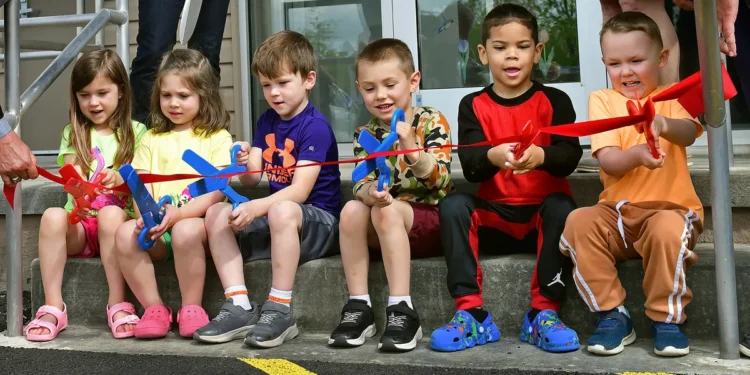Scott Alspach and his wife pay $5,500 per month for child care in Seattle for their two young children, their 3-year-old son attends a Green Lake center near their home, while their 1-year-old daughter is temporarily enrolled in a downtown program near her mother’s workplace.
Alspach, a tech worker whose wife is a doctor, can afford the cost but wonders: “I don’t understand how it is so expensive.”
Seattle ranks among the costliest U.S. cities for child care, with tuition costs spiking since 2020. The system faces multiple problems according to parents, providers, and advocates: workers are poorly paid and lack benefits with high turnover; families struggle with long waitlists and inconvenient schedules; providers face regulatory hurdles opening new facilities and expanding existing programs.
“There’s a child care crisis in a lot of ways throughout the state, and that includes the Seattle area, definitely,” said Emily Mikkelsen, Children’s Alliance early learning policy and coalition manager.
Beyond costs, availability, especially for young children, remains tight. Lois Martin, longtime director of the Community Day Center for Children in the Central District, says her center is booked until the 2026-27 school year.
“There aren’t enough slots, especially for infants through 2 years old,” Martin said. “It’s amazing to me how my parents even now are piecemealing things.”
The median 2024 price at King County centers was around $30,000 annually for an infant (0-11 months), $26,000 for a toddler (12-29 months), and $22,000 for a preschooler (30 months to 5 years), according to Child Care Aware of Washington.
Annual median costs at licensed home-based day cares were lower: around $21,000 for infants, $19,500 for toddlers, and $18,000 for preschoolers. Costs drop to around $5,000 annually when kids reach school age. The median means half the providers charge more, half less.
Families with two high-paying incomes say they’re struggling. “It’s outrageously expensive,” said Monica Mowatt, who attended a Kiddie Academy open house in Greenwood last month. Mowatt, a consultant, and her husband, a marketer, have paid for full-time care since their now-4-year-old was an infant. Both work remotely and plan to move to Chicago to be near family and escape Seattle’s high costs.
“For one of the top day care providers in that area, I’m about to pay about $500 less a month there than I do here,” Mowatt said.
Glenna Martin (no relation to center director Lois Martin) has two children, ages 1 and 4, attending Community Day Center for Children four days weekly. Their total cost is about $4,000 per month for part-time care, or $48,000 annually. Martin and her husband are family physicians at a community clinic. Even on doctors’ salaries, they’ve felt squeezed by child care costs while paying down $500,000 in combined student loan debt. Both have reduced hours to manage some care at home.
“Right now, we do four days a week and our center is gracious enough to prorate the expense; not every place does that,” Martin said. “Most places charge you five days a week, even if you don’t need five days a week of care.”
Seattle-area day care prices have risen sharply since 2020. The median for infant care increased by 55% in King County centers to $2,530 per month in 2024 and by 51% to $1,777 in home-based facilities, according to Child Care Aware. Costs for toddlers and preschoolers similarly spiked, while prices for school-age kids have been flat or declined in centers.
Providers say their operational costs have ballooned: food prices, insurance, construction materials, and staffing costs have shot up. A unique cost driver for Seattle centers is commercial space.
Jordan Crawley, Alki Beach Academy director of policy and operations in West Seattle, said commercial leases, permitting, and startup costs are high hurdles to opening or expanding facilities. Regulations also drive costs. Licensed day cares have state-mandated teacher-to-student ratios, group size limits by age, and space requirements.
“To get a midsize child care center open, you’re probably looking at 15 grand a month just in your lease, not counting” insurance, maintenance, and real estate taxes, Crawley said. “It’s going to be probably in the neighborhood of half a million dollars to get a program up and running.”
Alki, licensed for 127 children, scaled down plans to add 70 slots in a building next to its existing Frye Commerce Center facility over a zoning issue and settled on adding 30 slots. Permitting for that project has taken several months. New providers without revenue from existing operations usually can’t carry those costs, Crawley said.
The number of day cares has increased statewide and in King County since 2020. King County added 44 child care centers and 438 home-based day cares between 2020 and 2024, with a total of 662 centers and 1,737 home-based programs to start the year, according to the state Department of Children, Youth, and Families.
That hasn’t kept up with demand, according to advocates, noting most new facilities are home-based and restricted to 12 or fewer children. Crawley said only established providers are opening new centers.
“So, we’re not helping competition in the market at all, and that’s, I think, a big problem,” Crawley said, noting some providers charge well above the area’s median price. “One of the things that we’re seeing just because of the conditions in the market right now is that there are providers who are clearly taking advantage of a crisis in terms of what they charge for care.”
Advocates and other providers deny price gouging is happening.
Devinder Singh Josan, who owns six Kiddie Academy franchises in the Seattle area, opened a 17,000-square-foot center with three playgrounds in May in Greenwood. But that project almost didn’t happen, after buying a closed Walgreens building on Greenwood Avenue in 2020 with plans for a center, Josan shelved the project after construction and other costs surged. He and his wife, Rimmi, considered selling but were later convinced the neighborhood could sustain a large, private-pay facility. The center is licensed to serve 193 children with room to expand to 214, ages 6 weeks to 6 years.
There have been early challenges. The center quickly filled infant and toddler slots but has vacancies for preschool and school-age kids. Some 100 slots have been filled, leaving significant vacancies as of September’s open house.
Josan said many child care businesses struggle. “A lot of times providers … don’t have subtle knowledge about how to make good, prudent, sound financial business decisions. They go in with their heart first and then they don’t know money.”
Susan Brown, Kids Co. founder, a nonprofit with several school-based child care locations, said demand in Seattle is nuanced. Parents who qualify have low- or no-cost choices for preschoolers and school-age kids, including Seattle’s preschool program and federally funded Head Start program.
In a June survey of 38 Seattle-area centers by the Greater Seattle Child Care Business Coalition, some providers reported recent dips in preschooler enrollment, but demand for spots can be crushing for other age groups, particularly infants and toddlers. Waitlists can be as long as two years.
“You have to get on a waiting list before you’re even planning to get pregnant,” Brown said.
Centers typically need thriving preschool programs to cover the extra cost of providing infant-to-age-2 care. These programs are more expensive for parents but often not profitable. Infant and toddler rooms are more costly to keep open because of extra staffing required. So some providers won’t accept infants and toddlers.
Providers also struggle to attract and retain enough workers to meet state-mandated teacher-to-child ratio requirements, sometimes leaving licensed spots unfilled.
Child care workers often make around minimum wage and rarely get vacation and health benefits available in other professions. Often workers rely on the Affordable Care Act marketplace for health insurance.
“A lot of places aren’t able to offer health insurance because if you’re a smaller place, the cost is just too much,” said Martin, the Community Day Care director. Community Day Care for Children is licensed for 37 children but able to serve 39 because some kids go part time.
Aisha Uppal, a teacher there, has worked in centers on and off for eight years, quitting jobs over low pay and lack of support. She’s been at the day care the longest and gets nearly free care for her 18-month-old son. She loves working with children; most child care workers do. But turnover has been a problem at other centers.
“Ultimately I think it really does come down to how much people are being paid and people not feeling like it’s worth the time to work there, when they could be making $2, $3 more, just for example, like being a security guard,” Uppal said.
Problems with Washington’s child care system ripple beyond the industry. A significant number of parents miss work, quit jobs, or get fired over child care issues, according to a 2024 study commissioned by Child Care Aware.
Nearly 40% of 606 Washington parents with children under 12 who responded to a Zogby Analytics survey last year reported quitting jobs or being fired at least once because of child care disruptions. The study estimated child care-related absenteeism and turnover cost Washington employers around $4 billion in 2023. For workers who took time off or were out of work because of child care issues, lost income was estimated at around $2.9 billion that year.
Another issue is major Seattle-area employers like Amazon, Microsoft, and Starbucks calling remote workers back to offices. Day care providers say this hasn’t increased demand yet for care spots because remote workers already living here typically have kids enrolled, but it has caused problems for parents.
Tech worker Alspach, working fully remotely, said he’ll have to go back part of the week next year. “Returning to office is going to be a challenge for me. I have meetings that I take with people in different time zones, including in China, and they are getting up early to meet us at 5 p.m. but I have to pick up my kids at 5:30, so that’s going to be a challenge.”
Child care issues disproportionately impact women, said Genevieve Stokes, Child Care Aware of Washington director of government relations. “They tend to make less money in a two-earner household. And so, when decisions happen about who’s going to stay home, it is most common that they’re going to be the one that does, and that sets them back in their careers.”
For data scientists Kathleen Smith and John Hower, however, it was the opposite. Smith works at Microsoft and Hower previously was at Amazon. When their eldest, Felix, 5, was an infant they were paying a nanny $70,000 annually. In summer 2022, Hower quit his job to stay home in Ballard. As high earners, they could afford day care, but Hower said he was burned out and wanted to be home full time.
“I had already done a big chunk of leave during Felix’s first year alive and had really enjoyed it, and I wasn’t enjoying my job,” he said.
Smith said she would have preferred if both had flexibility to work part time but tech companies don’t tend to allow full-time workers to scale down workload to part time. Hower, planning to stay out of the workforce until their youngest, Andy, 1, reaches school age, is mulling a career change to become a math teacher.
They have felt the lost income and pressures of living in high-cost Seattle on one income. Microsoft has also had several recent rounds of layoffs, which is worrying. “Money is definitely tighter, so that’s a bit of a source of stress, especially on me,” Smith said. “If I lose my job, that’s a big deal.”







